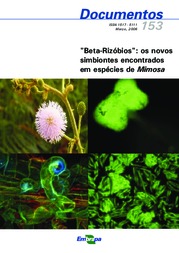"Beta-rizóbios": os novos simbiontes encontrados em espécies de Mimosa.
"Beta-rizóbios": os novos simbiontes encontrados em espécies de Mimosa.
Author(s): REIS JÚNIOR, F. B. dos; FARIA, S. M. de; MENDES, I. de C.; SIMON, M. F.; LOUREIRO, M. de F.; ELLIOT, G. N.; YOUNG, P.; SPRENT, J. I.; JAMES, E. K.
Summary: The fixation and transformation of atmospheric dinitrogen into ammonia and hence into organic e compounds is a crucial part of the nitrogen cycle. Nitrogenase, the enzyme responsible, has a wide taxonomie distribution in the bacteria and archaea, but is confined to a limited number of species. Among these, rhizobia, whieh form nodules on the roots of legumes, are recognised as the main contributors of biologieally-fixed nitrogen. Until recently, it has been generally accepted that legumes are nodulated exelusively by members of the alfa-proteobaeteria belonging to a number of related genera in the family Rhizobiaceae. In this document we review some results from recent studies that presents the newly-discovered beta-rhizobia which challenge the accepted century-old dogma that only Rhizobium and its relatives can nodulate legumes and provide a biodiversity dimension that was totally unexpected 6 years ago.
Publication year: 2006
Types of publication: Booklets
Unit: Embrapa Cerrados
Observation
Some of Embrapa's publications are published as ePub files. To read them, use or download one of the following free software options to your computer or mobile device. Android: Google Play Books; IOS: iBooks; Windows and Linux: Calibre.
Access other publications
Access the Agricultural Research Database (BDPA) to consult Embrapa's full library collection and records.
Visit Embrapa Bookstore to purchase books and other publications sold by Embrapa.


